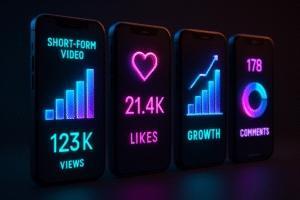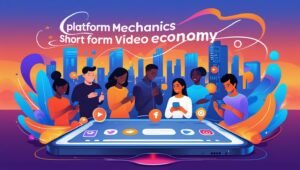1.Platform Mechanics That Determine Reach in the Short Form Video Economy
In the short form video economy, algorithms decide what goes viral and what disappears with a swipe. Understanding how feeds rank, test, and push content is the key to building consistent reach.
How Algorithms Rank Attention
Every video is scored by predicted viewer satisfaction. Platforms look at signals like:
- Watch time & completion rate – Did people watch the whole video?
- Negative feedback – Did they swipe immediately or mark it “not interested”?
- Post‑view actions – Did they replay, save, or share it?
All of this happens at swipe speed. Each impression is a new “test” of intent in the short form video economy.
The Tiered Distribution System
Platforms don’t send videos to everyone at once. Instead, reach is rolled out in stages:
- Test group – A small audience that matches the creator’s niche.
- Expansion group – If engagement passes benchmarks, it’s shown to broader lookalikes.
- Plateau or decay – If metrics drop, reach slows or stops.
This staged system prevents feed fatigue and ensures attention flows toward high‑quality, relevant content.
What Boosts Distribution
- Freshness: Recent uploads, trending sounds, or timely topics.
- Context: A user’s past viewing habits (niches, creators, formats).
- Quality/safety filters: Clean metadata, legible captions, originality, and policy compliance all determine eligibility for wide reach.
The Competition Inside Feeds
In the short form video economy, every swipe is a mini‑battle for attention. Competing factors include:
- Micro‑cohorts: Your video competes with content targeting similar interests, language, and device usage.
- Niche dominance > broad reach: Being consistently strong in a niche beats being average to everyone.
- Creator trust score: Posting consistently on a topic with steady satisfaction builds your profile, making it easier for future videos to spread.
- Category saturation: In crowded niches, small differences (first‑second retention, fewer negative signals) make or break a video’s reach.
Engagement Loops That Drive Growth
- Hooks win the first 2 seconds (contrast visuals, motion, promise text).
- Watch time & completion drive distribution if you maintain steady micro‑beats every 2–4 seconds.
- Replays send strong signals—use loops, reveals, or quick tutorials that reward a second viewing.
- Saves & shares carry more weight than likes: saves = long‑term value; shares = new audience exposure.
- Avoid negatives: Swipes, “not interested,” or mismatched captions suppress reach.
A Simple Creator Workflow
- Pre‑production: Write a one‑line promise, script the opening 3 seconds, and map attention beats.
- Production: Focus on clarity (large captions, clean visuals), unique audio, and modular shots.
- Post‑production: Experiment with variants (different openings, formats, captions). Measure retention at 3s, 5s, completion, plus saves & shares.
- Iteration: Double down on formats with high saves & shares. Retire those with good clicks but weak completions.
This loop—test, measure, refine—is the operating system of the short form video economy.
2. Monetization Realities in the Short Form Video Economy: What Actually Pays
The short form video economy doesn’t just shape culture—it also decides who can actually make a living. While millions of creators join platforms like TikTok, Instagram Reels, and YouTube Shorts, the path to steady income is rarely straightforward. Here’s what truly pays.
Core Revenue Streams
Ad Share
- Platforms split ad revenue with creators, but payouts vary by region and platform.
- In the short form video economy, ad RPMs (revenue per mille) are usually lower than long‑form, meaning creators need a larger catalog and higher volumes to earn at scale.
Brand Deals
- Sponsored shorts, UGC retainers, and licensing rights remain the most reliable revenue stream.
- Brands increasingly pay for authentic creator‑made content to reuse on their own channels.
Affiliate & Social Commerce
- Creators earn commissions on product links and in‑app shop sales.
- Best results come from repeatable formats: comparisons, “top 3 picks,” or practical how‑to breakdowns.
Subscriptions & Memberships
- Tools like Patreon, YouTube Memberships, or Instagram “Close Friends” offer recurring income.
- These stabilize earnings against the volatility of algorithmic reach.
Tips & Live Gifts
- Formats like Super Thanks, live badges, and TikTok gifts work best for interactive creators who engage their audience in real time.
YouTube Shorts Monetization Model
- Eligibility: Requires Partner Program approval, tied to watch‑time/subscriber milestones or Shorts‑specific thresholds.
- Revenue Share: Ad revenue is pooled, and creators are paid according to their share of total Shorts views (post music licensing).
- RPM Expectations: Lower than long‑form since one short = fewer ads. Successful creators stack Shorts with long‑form, memberships, live streams, and merch to maximize total channel revenue.
TikTok & Reels vs. YouTube Shorts
- TikTok: Unmatched discovery, but payouts are inconsistent. Strongest for brand deals, TikTok Shop, and rapid audience growth.
- Instagram Reels: Revenue often comes from sponsors, affiliate catalogs, and shop integrations. Best for lifestyle, beauty, and fashion niches.
- YouTube Shorts: The most stable platform payout. Plus, Shorts feed long‑form videos, live sessions, and memberships within the same channel—compounding income streams.
Net takeaway: In the short form video economy, each platform serves a unique role—TikTok for growth, Reels for brand alignment, Shorts for steady monetization.
Using Short Form as a Funnel to Monetize Elsewhere
Smart creators treat short‑form as a top‑of‑funnel engine to drive audiences into more durable products.
- Courses & Products: Shorts solve one step → full courses, templates, or tools solve the whole problem.
- Email & SMS Lists: Capture viewers with free guides or checklists. Owned lists = long‑term control.
- Services & Communities: Shorts act as proof of expertise; deeper monetization comes through coaching, consulting, or community access.
The Funnel Framework
- Content: Build around 3–5 repeatable short‑form pillars.
- Conversion: Add CTAs early (first 3s) and late (last 3s) with overlays and pinned comments.
- Tracking: Focus on save/share rate (intent), replay rate (value), outbound clicks (conversion), and downstream revenue attribution.
The Durable Playbook
To succeed long‑term in the short form video economy, creators must:
- Publish consistently at the pace platforms reward.
- Diversify income across ads, brand deals, products, and memberships.
- Convert algorithm‑driven reach into owned audiences and stable relationships.
That’s the difference between chasing viral spikes and actually building a business.
3) The New Creator P&L.
Posting cadence, editing time, and opportunity cost
- In the Short‑Form Video Economy, consistent output is a performance variable, not a vanity metric. A practical cadence for growth is 3–7 posts/week per platform, with each 30–60s short requiring 45–180 minutes end‑to‑end depending on complexity.
- Editing is the bottleneck: storyboarding (10–20 minutes), filming (15–40 minutes), edit with captions and sound design (30–90 minutes), and packaging (thumbnail/frame, title, description, tags) (10–20 minutes).
- Opportunity cost rises with complexity. Every 2–3 shorts often equals one long‑form video or a client deliverable; ruthless format discipline (series, templates, recurring hooks) preserves velocity and margin.
Team design: solo vs editor/producer model
- Solo operator: Maximum agility, lowest cash burn, but constrained throughput. Best for creators under 100k followers or highly niche formats. Invest in templates, macro hotkeys, caption presets, and batch days.
- Editor/producer pod: Creator on‑camera; part‑time editor; fractional producer (scripting, research, asset prep). This model doubles output while keeping creative voice intact.
- Studio‑style lane: Editor, motion designer, thumbnail/packaging specialist, channel strategist, and ops. Suitable when sponsorship pipeline or product revenue supports 4–8 shorts/week across platforms.
- Hand‑offs that work in the Short‑Form Video Economy: creator controls hooks and final cut; editor owns pacing, captions, and audio polish; producer owns briefs, beat maps, and asset kits.
Cost stack: tools, music licensing, captions, automation
- Tools: NLE (CapCut/Premiere/Final Cut), design (Canva/Figma), audio cleanup, stock B‑roll, and analytics. Expect $30–$150/month baseline.
- Music/licensing: Platform libraries reduce risk, but premium tracks/SFX packs can add $10–$50/month; clear rights workflows to avoid demonetization.
- Captions: Auto‑captioning plus manual proofing. Branded caption templates preserve identity and speed. Consider dedicated fonts and color kits.
- Automation: Cloud storage, snippet generators, upload schedulers, cross‑posting, and UTM/link management. Automate first comment, pinning, and playlisting. Aim for one-click repurposing to preserve margins across the Short‑Form Video Economy.
Burnout risks and sustainable velocity
- Leading indicators: declining hook quality, longer edit times, skipped rest days, and “content drift” from the core promise. Treat these as system failures, not personal shortcomings.
- Sustainable cadence design:
- Work in cycles (2 production days, 1 admin/learning day, 1 rest day).
- Batch record 6–12 hooks in one session; edit in 2–3 sprints.
- Use a 70/20/10 mix: 70% proven formats, 20% adjacencies, 10% experiments.
- Energy management: rotate series to avoid creative fatigue; maintain a swipe file of hooks, B‑roll, and beats; schedule digital sabbaths after campaign pushes.
- Quality guardrails: define “ship criteria” (hook clarity, legible captions, 2–3 beat map, clear CTA). If a draft fails two criteria, cut or re‑shoot instead of over‑editing.
- Personal P&L hygiene: track time per asset, direct costs, and revenue per short (platform, brand, affiliate). Sunset formats with low save/share elasticity, and double down on units with high replay and conversion. This is how creators hold margin while scaling output in the Short‑Form Video Economy.
4. AI and the Modern Production Stack in the Short Form Video Economy Workflow Acceleration: Scripting, Editing, Captioning, Repurposing.
AI compresses production cycles from hours to minutes in the short form video economy—if it’s guided by clear constraints.
- Scripting: Use ideation prompts, outline generators, and beat-mapping assistants to draft on-brand scripts fast. Define the audience, the promise, a hook template, and a tight 3-beat structure to keep outputs consistent.
- Editing: Automate cut-downs, silence removal, auto-zoom/pan, and jump-cut detection. Lock style with presets—fonts, color kits, lower-thirds—so variants stay visually consistent across platforms.
- Captioning: Auto-transcription with semantic timing, dynamic word highlights, and selective emoji/keyword emphasis can lift stop rate and retention. Keep captions high-contrast, 4–7 words per line, and anchored near focal areas.
- Repurposing: Start with one master asset, then spawn A/B hooks, trims (6–8s teasers, 15–30s reels, 45–60s explainers), and platform-native ratios. Maintain a metadata sheet (title, tags, CTA) for each variant to preserve measurement integrity in the short form video economy.
Long-to-Short Pipelines: Extractive vs Abstractive Summarization
- Extractive summarization: Pull the strongest moments verbatim from long videos, podcasts, or webinars. Great for clips with clear “aha” lines, demos, or reactions—authentic and fast, but sometimes light on narrative arc in 30–60s.
- Abstractive summarization: Rewrite source material into a fresh short with a tighter hook–problem–payoff. Delivers clarity and stronger conversion control, but needs editorial oversight to prevent hallucinations or lost nuance.
Virtual Creators and Synthetic Media Implications
- Virtual avatars: Real-time face/voice clones enable multilingual dubs, privacy-first creator brands, and 24/7 publishing. They reduce on-camera fatigue and localize quickly—ideal for knowledge and product content.
- Synthetic B-roll and scenes: Use generative visuals to fill coverage gaps, visualize abstractions, and upgrade production value without heavy shoots. Apply sparingly to avoid uncanny valley—anchor with real hands, screens, and products.
- Brand safety and disclosure: Clearly label AI-generated segments, maintain rights and consent for likeness/voice, and keep a provenance log (what’s generated vs recorded) to protect partnerships and platform compliance in the short form video economy.
- Economic shift: As AI lowers unit costs, differentiation moves to proprietary IP—unique frameworks, datasets, humor, voice, and editorial judgment. Commoditized topics will saturate; creators win by owning a distinctive POV.
Operational Guardrails and Measurement
- Human-in-the-loop: Keep people in the loop for hook selection, factual verification, and ethical review.
- Prompted style guides: Encode tone, pacing, and visual grammar into reusable prompts for consistent outputs.
- Latency budgets: Cap total AI processing per short (e.g., under 15 minutes) to match algorithmic posting cadence.
- Measurement: Compare AI-assisted vs fully manual outputs on stop rate, 3s/5s retention, completion, replays, saves, and downstream clicks to validate ROI in the short form video economy.
By pairing AI speed with human judgment, teams ship more, test faster, and compound learnings—turning creative into a scalable, defensible advantage in the short form video economy.
5) Fans, Community, and Economic Leverage
Platformized fandom: fans as marketers, patrons, and customers
- In the Short‑Form Video Economy, fans don’t just consume; they distribute. Shares, stitches, duets, and remixes multiply reach, turning engaged viewers into an extension of the marketing team.
- Patronage is now native: tips, live gifting, memberships, and in‑app shops convert attention into direct cash flow, while UGC testimonials and unboxing clips act as social proof that fuels algorithmic discovery.
- Treat every platform touchpoint as a lightweight funnel: short‑form for discovery, DMs/comments for dialogue, and owned channels for conversion—reducing reliance on volatile feed distribution.
Turning followers into superfans: memberships, gated content, community
- Superfans emerge when access deepens. Offer layered value: behind‑the‑scenes process, early drops, office‑hours Q&A, templates/presets, and member‑only series that compound skill or entertainment.
- Structure a clear value ladder: free shorts → email/SMS lead magnet → paid membership/community → premium products/services. Make on‑ramps obvious with consistent, low‑friction CTAs.
- Community design principles: set a shared mission, define rituals (weekly challenges, live critiques), and create recognition loops (badges, shout‑outs). Empower peer‑to‑peer help so value persists without constant creator presence.
- Operationalize retention: publish a monthly roadmap, rotate themes, and measure save/share ratio of member‑exclusive teasers inside public shorts to signal ongoing value in the Short‑Form Video Economy.
Micro‑niches and depth over breadth
- Depth compounds more than reach. Specificity—one problem, one persona, one transformation—raises save rates, reply quality, and willingness to pay.
- Codify a niche thesis: who is served, what pain is solved, and what recurring content formats deliver outcomes. This clarity sharpens hooks and reduces creative thrash.
- Build signature series that become identity anchors: repeatable formats with consistent promises (e.g., “30‑second teardown,” “1‑minute playbook,” “before/after”). Series lower production cost while increasing memorability.
- Monetize depth with aligned offers: micro‑courses, tools/templates, cohort workshops, and niche sponsorships where the audience‑to‑buyer overlap is high. In the Short‑Form Video Economy, precision targeting beats mass appeal for sustainable unit economics.
Practical playbook
- Map the funnel: 3 discovery series (shorts), 1 conversion asset (lead magnet), 1 community container (membership/Discord/Groups), and 1 flagship offer.
- Ship community rituals: weekly AMA, monthly challenge, quarterly milestone event; announce via short‑form teasers to convert passive viewers into participants.
- Measure leverage, not vanity: save/share rate, comment quality, member retention, LTV/CAC, and community‑generated content volume. Optimize for participation density—the true currency of economic leverage in the Short‑Form Video Economy.
6)Content Strategy in the Short Form Video Economy: From Hooks to Habits
The short form video economy thrives on one thing: retention. To win attention and keep it, creators must master the grammar of high‑retention shorts, blending pattern interrupts, smart pacing, and intentional CTA design. Let’s break down the key strategies.
Pattern Interrupts: Capturing Attention in Seconds
In the short form video economy, the first 1–2 seconds decide whether someone keeps watching or scrolls away. Use:
- Motion or contrast to jolt curiosity.
- Contrarian statements to challenge assumptions.
- Tight framing, bold on‑screen text, and sharp audio cues to anchor attention instantly.
These tactics spike stop rates and set up the rest of the story.
Pacing: Sustaining Cognitive Novelty
Attention naturally decays, which is why pacing is critical. The rhythm of a short should shift every 2–4 seconds using:
- Quick cuts, zooms, or crops
- Overlays and transitions
- Sound shifts or beats
- The goal is to keep visual continuity intact while constantly refreshing focus—an essential principle in the short form video economy.
CTA Design: Conversion Without Friction
Not all CTAs are equal. In short‑form content:
- Value before the ask: tease the benefit first.
- Introduce micro‑CTAs mid‑roll (e.g., “save this tip”).
- End with bridging CTAs—pointing to a playlist, next episode, or owned channel.
CTAs in the short form video economy should be brief, high‑contrast, and under 6–8 words for clarity.
Story Beats for 15–60 Second Narratives
Every high‑performing short follows a lightweight narrative arc:
- Hook: Promise an outcome or tension in under 2s.
- Context: Frame the stakes in one sentence.
- Payload: Share 2–3 quick examples or steps.
- Payoff: Show the result, punchline, or transformation.
- Bridge: Move the viewer to the next asset—another short, a playlist, or your channel.
This modular storytelling structure is what makes the short form video economy scale effectively.
Edutainment vs. Entertainment
Both styles fuel growth for different reasons:
- Edutainment: Combines education + spectacle (screen recordings, demos, checklists). Works because it drives saves and shares, giving long‑tail reach.
- Entertainment: Relies on surprise, humor, or emotion (sketches, reactions, challenges). Optimized for replays and virality.
The most sustainable creators in the short form video economy blend these approaches—delivering one takeaway and one entertainment beat per short.
Series Design and Habit Formation
Viral spikes are temporary; habits build durability. To grow steadily in the short form video economy, creators should:
- Launch signature series with a clear promise and flexible inputs (e.g., “1‑Minute Fixes”).
- Use part numbers and playlists to extend watch chains.
- Tease the next episode in the final seconds and pin a comment linking to the hub.
- Maintain a predictable cadence, visual identity, and proven hooks to reinforce recognition.
This habit‑first approach creates compounding growth far beyond any one viral hit.
7. Distribution and Omnichannel Play in the Short Form Video Economy
Winning distribution in the short form video economy means designing once, packaging natively, and turning feed attention into owned relationships and revenue.
Cross‑posting: Adapt for Shorts, Reels, and TikTok
- Format once, package thrice: export platform‑native ratios, tweak captions, and adjust on‑screen UI so elements aren’t covered.
- Localize the first frame: keep hook text and the subject clear of logos, subtitles, and interface zones unique to each app.
- Metadata hygiene: align titles, keywords, and thumbnail frames to each platform’s discovery grammar, while keeping the core narrative identical for clean measurement in the short form video economy.
Timing, Frequency, and Sequencing
- Timing: post when the audience is active, but protect a repeatable production rhythm over chasing minute‑by‑minute peaks.
- Frequency: 3–7 posts/week per platform is sustainable; batch record and stagger releases to stay consistent.
- Sequencing: launch the anchor short where native reach is strongest, then cascade to other platforms within 24–48 hours. Extend discovery with follow‑ups (FAQ replies, stitches, remixes).
- Bridge to Owned Channels: Email, Community, SMS
- Always‑on bridge: pin comments and profile links to a single rotating lead magnet (checklist, template, mini‑lesson) to convert attention into owned contacts.
- Onboarding flow: send a welcome email with quick wins, a 5‑day drip that deepens the promise, and a weekly cadence that mirrors short‑form themes.
- Community funnel: move high‑intent viewers into a lightweight space (Discord, Circle, Geneva) with rituals—weekly challenges and office hours—so participation compounds in the short form video economy.
Shoppable Video and Social Commerce
- Native shops: use product tags, affiliate links, and in‑app carts to remove friction from inspiration to purchase.
- Creative formats that convert: before/after demos, three‑reason lists, side‑by‑sides, and UGC testimonials. Put price, benefit, and proof in the first 5–7 seconds to match feed velocity.
- Measurement stack: track save/share rate (intent), replay rate (curiosity), product page CTR, add‑to‑cart, and conversion lag. Iterate hooks and offers weekly to keep the feedback loop tight.
Operating Principle
Design once for the feed, distribute everywhere with native packaging, and always bridge discovery to owned channels and shoppable surfaces. That’s how distribution compounds into revenue in the short form video economy.
8.Brand Deals, Pricing, and Proof in the Short Form Video Economy
In the short form video economy, brand partnerships have rapidly evolved from one‑off influencer shoutouts to performance‑driven, ongoing collaborations. Instead of paying for impressions alone, brands now want measurable lift—click‑throughs, sign‑ups, and conversions. That shift has changed how creators package, price, and prove their value.
From Influencers to Agile Creative Partners
Creators today act more like micro production studios. They don’t just post a single ad; they produce iterative assets, test multiple hooks, and deliver fresh variants that align with the rapid cadence of short‑form feeds.
Brands increasingly bundle media and creative. A video that performs well organically is then licensed as an ad (via whitelisting or “dark posting”) to maximize return on spend. This allows brands to squeeze more ROI out of proven hooks and edits in the short form video economy.
Packaging Short‑Form Deliverables
When negotiating brand deals, clarity on deliverables is critical:
- Assets: e.g., 3 x 15–30s videos, vertical formats (9:16, 1:1), raw footage, and A/B alternative hooks.
- Usage Rights: organic vs. paid use; 30–180 days; defined regions. Longer or wider usage = higher rates.
- Whitelisting/Spark Ads: permission for brands to run ads under your handle. Charge a monthly fee plus a tier‑based rate tied to media spend.
- UGC Licensing: separate fee when brands use your content for their channels, landing pages, or marketplaces. Standard in the short form video economy.
Pricing Frameworks
Rates are shaped by these factors:
- Audience Fit: niche alignment increases conversions and price.
- Performance History: high retention, saves/shares, and click‑throughs justify premiums.
- Creative Complexity: custom sets, advanced edits, or multiple variants raise scope.
- Rights & Duration: extended licensing, whitelisting, and exclusivity push rates up.
- Turnaround & Exclusivity: faster delivery and category lockouts command surcharges.
- A common deal structure: base asset fee + variant fee + paid usage (30–90 days) + whitelisting monthly fee + exclusivity premium.
Proof That Converts Brands
To close deals, creators must show proof beyond vanity metrics. What brands look for:
- Retention & Completion Rates: steady watch curves = strong messaging.
- Saves & Shares: saves suggest purchase intent, shares expand reach.
- Replays: signal novelty or strong utility, ideal for paid ads.
- Conversion Data: click‑through, add‑to‑cart, and tracked purchases.
- The best approach is to build a proof deck: 1‑page creative thesis, 3 performance snapshots, audience demos, plus top‑performing hook styles. This evidence helps creators anchor pricing and demonstrate ROI inside the short form video economy.
9) Policy, Compliance, and Risk.
Music and IP safety, advertiser‑friendly guidelines.
- Use platform‑cleared music libraries or licensed tracks; document licenses and avoid copyrighted samples in commercial deals.
- Respect trademarks, logos, and third‑party likenesses; secure permissions for product shots in retail settings.
- Follow advertiser‑friendly rules: avoid unsafe content categories, make claims substantiable, and include disclosures for gifts/ads.
- Keep a compliance checklist per asset: rights, claims, safety tags, and disclosure language—standard operating hygiene in the Short‑Form Video Economy.
Monetization thresholds and platform eligibility
- Eligibility typically requires meeting follower/subscriber and view/watch metrics, plus compliance with community and monetization policies.
- Maintain originality: avoid compilations and reused content without transformative edits; repeated policy strikes can remove monetization.
- Keep documentation handy: ID verification, tax forms, and payout details to prevent delays when programs unlock.
Algorithm volatility and platform dependency risk
- Platforms rebalance feeds, ad loads, and policy enforcement; reach can swing week to week.
- Hedge by diversifying: run a multi‑platform presence, build an email/SMS list, and create repeatable series to stabilize baseline views in the Short‑Form Video Economy.
- Protect revenue with a stack: platform payouts + brand retainers + affiliates/shops + owned products—so a single algorithm change doesn’t crater cash flow.
Regional governance and market‑specific policies
- Rules vary by country: data protection, advertising disclosures, and age‑targeting constraints affect creative and tracking.
- Music and IP regimes differ; some regions have stricter performance and synchronization requirements.
- Plan for contingencies: maintain alternate distribution (e.g., Shorts/Reels where certain apps are restricted), localize disclosures, and prepare region‑specific claim substantiation.
- For cross‑border campaigns: align offer language, pricing display, and data consent flows with local norms to reduce ad disapprovals and maximize throughput within the Short‑Form Video Economy.
10) Sector Lenses and Under‑Served Creators
Opportunities and challenges for senior and non‑traditional creators
- Opportunity: Experience is a moat. Senior professionals and non‑traditional voices can win with authority-led formats (1‑minute frameworks, “office‑hours” Q&A, before/after case studies). In the Short‑Form Video Economy, depth and credibility convert to higher willingness to pay.
- Challenge: Production friction and on‑camera comfort. Solve with templated scripts, teleprompter workflows, and voiceover + B‑roll formats to reduce performance anxiety.
- Monetization edge: B2B, coaching, and high‑ticket services align well with precise, problem‑solving shorts; smaller audiences can still yield strong revenue per viewer.
Lessons from China’s fan‑economy operations (Douyin/Kuaishou ecosystems)
- Always‑on live + short‑form flywheel: Short clips seed discovery; live drives trust and conversion. Adopt a “clip→live→offer” cadence for launches.
- Commerce-native content: Demonstrations, limited-time bundles, and social-proof overlays (comments, purchases) compress the path to purchase.
- Operational rigor: Daily posting, SKU depth, and creator–merchant collabs power scale. Western creators can mirror this with shoppable video, waitlists, and timeboxed promos within the Short‑Form Video Economy.
Niche verticals: education, finance, beauty, gaming, local services
- Education: Micro‑curricula and stepwise demonstrations boost saves and replays; monetize with courses, templates, and cohorts.
- Finance: Compliance-first content, clear disclaimers, and scenario walkthroughs. Trust compounding > virality; memberships and newsletters perform well.
- Beauty: Routine breakdowns, ingredient explainers, and side‑by‑side tests; seamless tie-ins to affiliate and shoppable video.
- Gaming: Tips, speedrun mechanics, patch recaps; strong replay elasticity and sponsor alignment (peripherals, energy, SaaS tools).
- Local services: Geo-tagged before/after reels, testimonials, and quote estimators; convert via DM, forms, and SMS—proof-driven plays that flourish in the Short‑Form Video Economy.
11.Data‑Driven Creative: Metrics That Matter in the Short Form Video Economy

In the short form video economy, views alone don’t define success. What truly matters are deeper engagement metrics that signal lasting impact and audience connection. Understanding and optimizing these metrics can turn content from one‑off hits into compounding growth.
Average View Duration (AVD) and Completion Rate (CR) form the backbone of measurement. AVD shows how much of a video people actually consume, while CR reveals whether pacing and clarity are on point. For 15–30 second clips, aim for high completion rates. For 45–60 seconds, prioritize smooth retention by adding micro‑beats every 2–4 seconds. These two metrics often determine if a video will “graduate” from test groups into wider distribution within the short form video economy.
Repeat viewers are another powerful signal. A strong 7‑day or 28‑day repeat viewer ratio confirms that your promise and format resonate. Series that encourage repeat consumption should move to the front of your content calendar.
Saves and shares signal intent and value. A save means viewers plan to revisit or apply your content, often predicting future conversions. Shares, meanwhile, expand your reach into new networks. Use checklists, frameworks, or quick tutorials with clear captions and clean typography to maximize saves and shares.
Session starts and replays are equally vital. If a short begins a new viewing session, it proves your hook is broad and compelling. Replays—caused by loops, reveals, or dense tips—boost satisfaction signals and ranking.
To simplify analysis, use a metric ladder:
- Stop rate (first‑2s hook)
- AVD/CR (consumption)
- Replays (novelty/utility)
- Saves (intent)
- Shares (network growth)
- Session starts & follows (habit)
- Click‑through & conversions (business impact)
- Finally, embrace variant testing. Publish multiple hook or caption versions, measure on AVD and CR first, and scale what performs. Winning creatives can become series and playlists—compounding results over time.
This data‑driven workflow ensures your content isn’t just viral, but predictable and repeatable inside the short form video economy.
12) Playbooks and Frameworks
Zero‑to‑one: niche selection, narrative pillars, posting cadence
- Define a sharp niche thesis: one persona, one recurring pain, one promised transformation. Validate with 10–20 short ideas that pass the “specific, solvable, showable” test.
- Establish 3 narrative pillars (e.g., Teardowns, Playbooks, Proof) with 2–3 repeatable formats each. This reduces friction and trains audience expectation within the Short‑Form Video Economy.
- Cadence: 3–7 shorts/week. Work in weekly cycles: 1 ideation session, 1–2 production blocks, 1 iteration block. Maintain a 70/20/10 mix: 70% proven, 20% adjacent, 10% experiments.
The long‑to‑short pipeline: ideation, scripting, editing, iteration loops
- Ideation: mine FAQs, comments, search cues, and audience wins/losses. Map each idea to a 1‑line promise.
- Scripting: write the first 3 seconds (pattern interrupt + outcome), then a 3‑beat payload and 1 bridge CTA.
- Editing: front‑load motion and legible captions; beat every 2–4s; keep overlays under 6–8 words.
- Iteration: publish variants (two hooks, two captions). Double down on units with strong completion, saves, and replays—the core currency of the Short‑Form Video Economy.
Repurposing matrix across formats and channels
- Vertical 9:16 → trim for 6–8s teaser, 15–30s how‑to, 45–60s explainer.
- Cross‑platform packaging: adjust first frame, captions, sounds, and metadata to fit Shorts, Reels, TikTok.
- Expand to owned: convert a 3‑beat short into an email tip, carousel, blog snippet, and community prompt.
Experimentation system: A/B hooks, thumbnails, captions, lengths
- Hooks: test promise framing (outcome‑first vs contrarian), visual contrast, and question vs command.
- Thumbnails/frame selects: pick distinct first frames; avoid UI collisions.
- Captions: test semantic emphasis (verbs/numbers/emojis), reading age, and CTA language.
- Lengths: 8–12s for punchlines and reveals; 15–30s for playbooks; 45–60s for mini‑narratives. Track stop rate, AVD, completion, saves, and shares.
13) The Creator Business Stack
Productization paths: digital products, cohorts, memberships, SaaS
- Laddered offers: free lead magnet → low‑ticket templates/tools → mid‑ticket courses/cohorts → high‑ticket services or SaaS.
- Cohorts: time‑boxed accountability and feedback; price on outcome and access.
- Memberships: ongoing assets (templates, office hours, community rituals) that stabilize revenue in the Short‑Form Video Economy.
Commerce enablers: checkout, fulfillment, affiliate networks
- Checkout: frictionless, mobile‑first, with upsells/downsells and instant file delivery.
- Fulfillment: automate emails, access, and updates; use customer hubs for versioning.
- Affiliate: align with niche‑native products; standardize disclosure and tracking; build evergreen comparison shorts.
Financial ops: revenue diversification, cash flow smoothing, taxes
- Diversify across platform payouts, brand retainers, affiliates/shops, and owned products to hedge algorithm shifts.
- Cash flow: target 3–6 months runway; invoice upfront or milestone; use rolling launches for predictable inflows.
- Taxes: separate accounts, track COGS (tools, music, contractors), and set aside a fixed tax percentage from each payout.
14) Ethics, Quality, and Safety
Authenticity vs algorithmic optimization
- Lead with truth and lived expertise; let optimization serve clarity, not manipulation.
- Avoid clickbait promise gaps. Calibrate hooks to deliver precisely what the audience expects—trust compounds in the Short‑Form Video Economy.
Misinformation and responsible content practices
- Cite credible sources when stating facts; show your work with on‑screen references or pinned comments.
- Use clear disclaimers for finance/health; avoid unverifiable claims and synthetic proof.
Accessibility: captions, contrast, reading age, inclusive design
- Always‑on, high‑contrast captions sized for small screens; 4–7 words per line.
- Use simple language (grade 6–8), descriptive alt text where supported, and color‑safe palettes.
- Design inclusively: avoid rapid flashing, provide context for sound‑off viewing, and localize language where possible.
Operating principle: build repeatable, ethical systems that turn discovery into durable relationship and revenue flywheels—at a sustainable cadence—inside the Short‑Form Video Economy.
15) Outlook 2025–2027: What’s Next
Ad budgets shift toward creator‑led performance marketing
- Expect a continued pivot from static ads to creator‑made, performance‑tracked short‑form units, with brands bundling creative + media in ongoing retainers.
- Always‑on UGC pipelines become standard: creators deliver monthly asset packs with variant testing, while brands whitelist top performers for paid scale.
- Attribution tightens: saves, replays, and session starts become pre‑purchase proxies; incrementality tests and SKU‑level tracking inform budget shifts in the Short‑Form Video Economy.
AI‑native production and personalized media at scale
- Generative scripting, voice, and video will compress production cycles; creators ship multilingual variants, persona‑specific hooks, and dynamic CTAs in minutes.
- Personalization moves from audience segments to “micro‑cohorts,” with creative tailored to context (device, time, interest graph).
- Differentiation shifts to proprietary IP—frameworks, datasets, and editorial taste—since AI drives down commodity content costs.
Evolving rev‑share and social commerce maturity
- Revenue share programs broaden but remain tiered by originality, brand safety, and engagement quality; long‑form and live continue to carry higher RPMs.
- Native shops, affiliate rails, and shoppable video streamline checkout; creators that master productization and conversion design capture outsize value in the Short‑Form Video Economy.
- Expect clearer policies on music/IP and paid usage, with standardized licensing menus for creator assets in paid media.
Building durable value: from rented reach to owned relationships
- The moat is an owned audience: email/SMS, memberships, and communities reduce platform risk and stabilize revenue.
- Series/IP that travel across platforms—plus a portfolio of digital products or services—create compounding cash flows.
- Operating system: publish at algorithmic cadence, convert to owned channels, and ladder offers from low‑ticket to high‑ticket.
16) Case Studies and Templates
creator archetypes: educator, entertainer, entrepreneur
- Educator: promises transformation. Formats: “1‑Minute Frameworks,” “3‑Step Demos.” Monetization: courses, templates, cohorts. Proof: saves, completion, repeat viewers. Short‑Form Video Economy edge: high save elasticity.
- Entertainer: promises emotion. Formats: sketches, challenges, reactions. Monetization: brand deals, live, merch. Proof: replays, shares, session starts. Edge: viral velocity and paid whitelisting potential.
- Entrepreneur: promises outcomes + offers. Formats: case studies, teardown → CTA. Monetization: services, SaaS, high‑ticket programs. Proof: click‑through, booked calls, revenue. Edge: high revenue per viewer.
Week‑by‑week launch plan for a new short‑form channel (6 weeks)
- Week 1: Niche thesis, 3 pillars, 12 hooks. Build caption/branding templates. Record 6 seed videos.
- Week 2: Publish 5; test two hook variants on 2 ideas. Track stop rate, completion.
- Week 3: Publish 5; introduce a series. Add lead magnet; pin comments/links.
- Week 4: Publish 5; begin email/SMS onboarding. Create 2 shoppable or affiliate experiments.
- Week 5: Publish 5; launch a live Q&A. Start a weekly newsletter mirroring shorts.
- Week 6: Publish 5; ship a low‑ticket product or cohort waitlist. Retire bottom 20% formats; double down on top 20%.
Negotiation checklist for short‑form brand packages
- Scope: number/length of assets, variants, raw files.
- Rights: organic vs paid usage, duration, geos, whitelisting.
- Deliverables: hooks A/B, captions, subtitles, alt cuts.
- Timelines: draft, revisions, go‑live dates; rush fees.
- Exclusivity: categories, duration, surcharge.
- Proof: retention curves, saves/shares, prior ROAS or CTR.
- Compliance: disclosures, claims substantiation, music/IP.
- Measurement: UTMs, pixel events, success KPIs, reporting cadence.
- Payment: base + usage + whitelisting monthly + performance bonus.
KPI dashboard template for shorts‑led growth
- Attention quality: stop rate (first‑2s hold), average view duration, completion rate.
- Resonance: replays, saves, shares; comments per 1,000 views.
- Growth: session starts, follows/subscribers, repeat viewers (7/28‑day).
- Conversion: profile clicks, link CTR, add‑to‑cart, conversion rate, revenue.
- Production ops: time per asset, variant count, cost per asset, posting cadence adherence.
- Portfolio health: top 10% assets by saves/share elasticity; bottom 10% for sunset.
- Funnel: lead capture rate, email open/click, membership retention, LTV/CAC.
Operate these playbooks consistently, and compounding attention turns into durable revenue and relationships within the Short‑Form Video Economy.
Conclusion: Playing the Infinite Game in the Short Form Video Economy
Winning in the short form video economy isn’t about chasing viral spikes—it’s about playing the long game. Growth that lasts comes from compounding attention: first through retention (clear hooks, tight pacing, and satisfying payoffs), then through relationships (consistent series, interactive dialogue, and content worth saving or sharing). The real engine is repeatability. Signature formats and narrative structures reduce creative friction, keep quality high, and train audiences on what to expect every time.
Sustainability also means diversification. Trusting algorithms alone is risky. Spread your content across YouTube Shorts, Instagram Reels, and TikTok, but always build bridges to your owned channels—email lists, communities, memberships—where reach and relationships are durable. The same applies to revenue: stack multiple streams by combining ad payouts with brand partnerships, affiliate commerce, and productized knowledge. In the short form video economy, resilience comes from a balanced mix of channels and cash flows.
Iteration is another cornerstone. Instead of chasing perfection, ship small and fast. Test multiple hooks, captions, and angles, then let the data guide you. Track the metrics that matter most:
- Session starts for discoverability,
- Repeat viewers for habit formation,
- Saves and shares for compounding reach,
- Conversions for business impact.
- Retire formats that don’t perform and invest more into the ones with high “save/share elasticity.” Keep the cadence manageable by using templates, batch production, and simple workflows—ensuring creative energy lasts over the long haul.
The infinite game of the short form video economy is about compounding—small, repeatable wins that stack over time. Build intellectual property, nurture your community, and focus on sustainable growth. With patient iteration and diversified strategy, incremental gains will eventually turn into outsized outcomes.
Also visit our other article onlinedigigyan.








